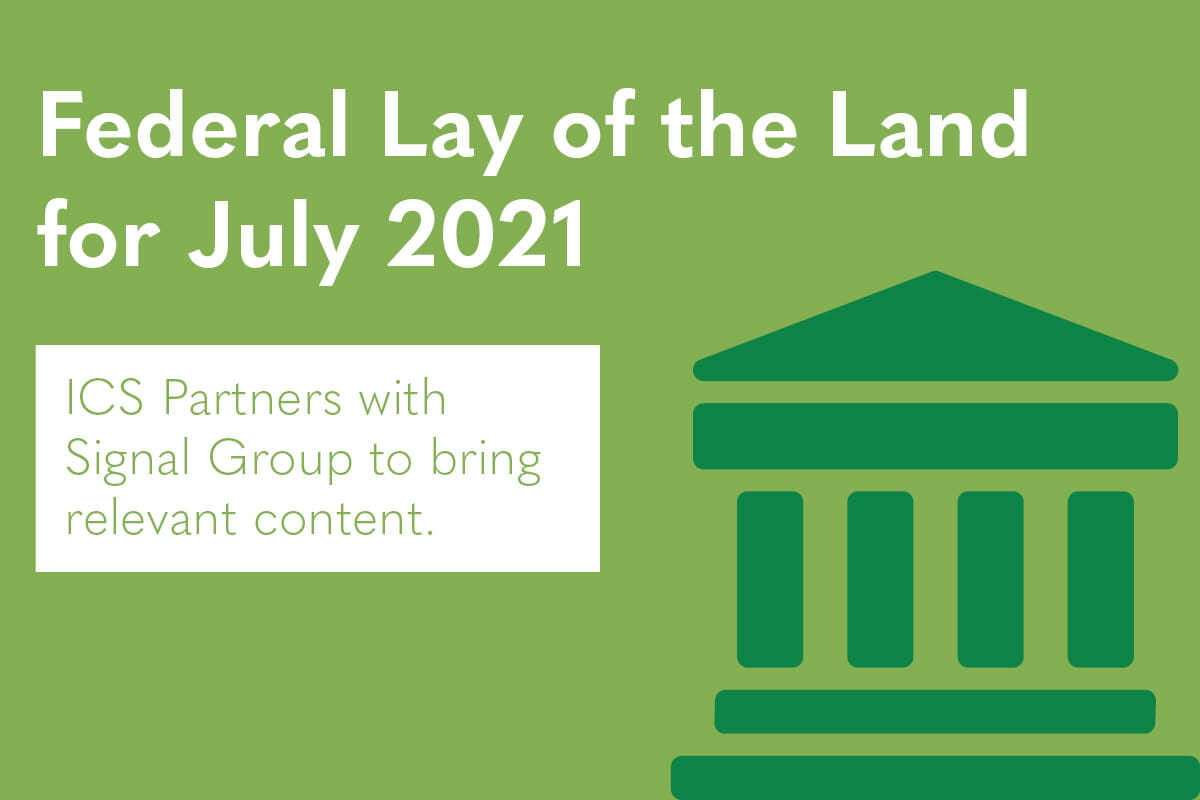In collaboration with Signal Group, here’s the Federal Lay of the Land for July 2021. For more information, please reach out to Dave Bergeron at dave.bergeron@ics-builds.com.

Economic Markers
Gross Domestic Product: The latest data from the Bureau of Economic Analysis estimated that U.S. GDP grew at an annualized rate of 6.4% in the first quarter of 2021 – fueled by government stimulus, the re-opening of businesses, and an increased pace of vaccinations. This third estimate of Q1 data was released on June 24 and confirms earlier predictions that real GDP had recovered to 93% of its pre-pandemic levels as of the end of March 2021. BEA will release its advance estimate of Q2 GDP on July 29.
Employment: According to data from the Bureau of Labor Statistics, the unemployment rate was little changed in June, increasing by less than 0.1 points from 5.8% to 5.9%. This figure remains far above its pre-pandemic level of 4.5% in February 2020. Following 3 straight months of significant decreases, the unemployment rate for the construction industry increased in June, rising by 0.8 points to 7.5% from its rate of 6.7% in May. The June rate is up 2 points from its pre-pandemic level of 5.5% in February 2020.
A complicating factor in the return to work for millions who became unemployed due to the pandemic is continued emergency unemployment benefits. A recent poll conducted by Morning Consult concluded that an estimated 1.8 million Americans cited their top reason for turning down job offers while unemployed was that they are receiving enough money from unemployment insurance to get by. The interplay between employment numbers and benefits will be important to track as emergency pandemic unemployment insurance subsides on September 6. BLS will release July’s unemployment report on August 6.
Inflation Concerns: As infrastructure spending negotiations on Capitol Hill continue into the summer, inflation concerns remain a major sticking point. Republicans are expressing their worry that rising inflation could turn into long-term runaway inflation. Democrats and Federal Reserve Chair Jerome Powell are maintaining that these price increases are temporary in nature, or ‘transitory,’ and are due to the unprecedented nature of re-starting an economy ground to a self-imposed halt.
According to the Bureau of Labor Statistics’ latest Consumer Price Index (CPI) data released on July 13, price levels rose 0.9% between May and June and are now up 5.4% compared to June 2020. While 2020 is considered by many to provide a false baseline due to the pandemic’s sudden price-suppressing effects, prices have risen 6% between June 2019 and June 2021. This average rate of 3% per year is still far above the Fed’s target rate of 2%.
While the position of the Fed and many mainstream economists is that this inflation is transitory in nature, and due solely to the reinvigoration of the economy rather than a traditional overheating, experts appear increasingly unsure about how long this transitory period will be. Federal Reserve Governor Michelle Bowman and Atlanta Federal Reserve President Raphael Bostic said last month that transitory may look more like 6-9 months than the previously estimated 3-6 months.
Federal Reserve Chairman Jerome Powell maintained his stance on the issue, during Congressional hearings before the House Financial Services Committee on July 14 and the Senate Banking Committee on July 15 but did acknowledge that initial readings may have underestimated the inflation risk, stating:
“We’re experiencing a big uptick in inflation, bigger than many expected, bigger than certainly I expected, and we’re trying to understand whether it’s something that will pass through fairly quickly, or whether, in fact, we need to act. One way or another, we’re not going to be going into a period of high inflation for a long period of time, because of course we have the tools to address that.”
Powell’s team has stated plans to hold interest rates near-zero until 2023.
While Federal Reserve officials and others in the Biden Administration are remaining optimistic, CEOs of major U.S. companies do not have such a rosy outlook. Many have publicly raised their concerns on earnings calls and in the press following the release of the latest numbers. Additionally, 197/500 S&P 500 companies discussed inflation on their Q1 earnings calls in June – the highest number in over 10 years. BLS will release July’s CPI numbers on August 11.
Infrastructure Negotiations
Talks between the Biden Administration and Congress over an infrastructure package have ramped up in recent weeks but remain tenuous and continue to change by the minute.
The infrastructure spending that ultimately makes its way across the finish line will likely come in the form of two separate packages – a smaller bipartisan deal that passes under normal procedure, receiving at least 60 votes in the Senate, including 10 minimum Republican votes, and a larger package passed without Republican support utilizing the budget reconciliation framework. A successful reconciliation bill would require all 50 Democrats to agree – no minor task by any stretch – but bypasses the 60-vote threshold needed to defeat the filibuster.
At the time of this writing, a bipartisan group of 21 Senators is engaged in talks over the first, smaller package, a roughly $1 trillion physical infrastructure package. While this group includes enough Republicans to pass a bill, these talks have been notably fragile, and could fall apart at any moment. Regardless, it is likely that sectors like surface transportation, broadband, and water infrastructure that enjoy bipartisan support may pass under normal procedure sometime before the end of September.
Separately, Democrats have reportedly come to an agreement on a $3.5 trillion budget reconciliation package that includes more progressive items related to climate, child care, health care, and labor. Education-related spending in this package includes universal pre-K funding, and investments in community colleges, HBCUs, and minority-serving institutions. It should be noted that while publicly this package is said to have consensus amongst Democrats, beltway insiders are skeptical that this is really true, and think support may wane as more specific provisions are released.
A series of test votes scheduled by Senate Majority Leader Chuck Schumer for the week of July 19 and beyond will force Senators’ hand on what they are willing to throw their weight behind with official votes, rather than politically motivated statements in the press. These measures will provide clarity as lawmakers sprint to get at least one package signed into law in time to get out of town for the upcoming August recess. Republicans participating in the bipartisan negotiations including Sen. Bill Cassidy of Louisiana have blasted Schumer for forcing a quick vote, saying that he is not involved in the negotiations and needs to give the group more time to build a consensus.
Notably, neither of the packages currently under consideration contain the school infrastructure provisions included in President Biden’s American Jobs Plan framework, which proposes key school investments including:
- $50 billion in grants and $50 billion in bonds for K-12 infrastructure
- $12 billion in grants for community college infrastructure
As dealmaking continues to be hashed out, it remains to be seen whether these provisions make it into either package.
American Rescue Plan Funding
The American Rescue Plan – passed in March 2021 – allocated $122.7 billion in ESSER III funding for K-12 schools, with eligible uses of funds left intentionally broad, intended to meet the specific needs of each school district.
ESSER III Applications Due October 1, 2021: Each district must complete both an application for FIN16/includes facility work and for FIN161/ devoted to learning loss programming to include a safe return to in-person learning plan, asset map, needs assessment, community engagement, tribal consultation.
Flow of Funds: The first two-thirds of funds – approximately $81 billion – were released in March by the Department of Education to State Education Agencies (SEAs). Upon receipt of funds, SEAs were given 60 days to make funds available to Local Education Agencies (LEAs). By the end of May, all LEAs should have become able to apply to their SEA for their portion of this $81 billion via a subgrant.
The final one-third of ESSER III funds – approximately $41 billion – is predicated upon states submitting plans to the Department of Education outlining their use for these funds. To date, 38 states and the District of Columbia have submitted plans that the department has publicly posted on their website. Of these 39 SEA plans, 12 have been approved and funds have been released by the department. The same 60-day requirement for SEAs to make funds available for subgrant applications by LEAs is in place for the second release of funds. LEAs that receive ESSER III subgrant funding from SEAs have until September 30, 2024, to obligate all funds.
